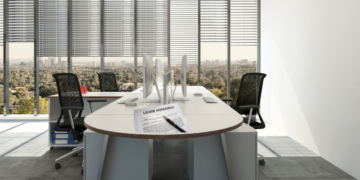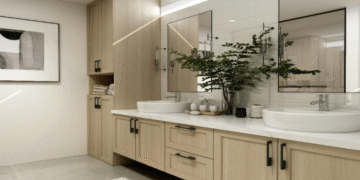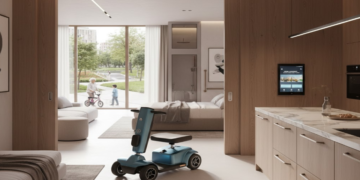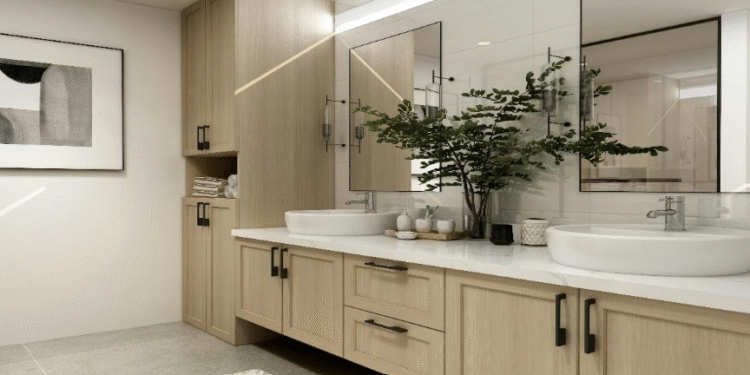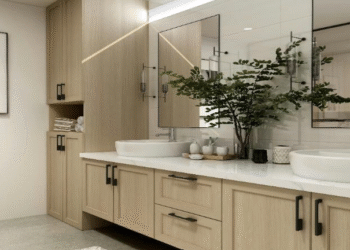Designing a space that perfectly balances function and beauty is an art form. Every detail, from the layout to the lighting, contributes to how a room feels and how well it works for those who use it.
The smartest designs are not necessarily the most extravagant; they are the ones that serve a purpose while looking effortlessly elegant. A well-designed space not only enhances comfort but also reflects personality and thoughtfulness.
When approaching any design project, the key lies in making intentional choices—ones that add value, convenience, and a sense of harmony. Whether it’s a small apartment or a large home, smart design principles can elevate every corner into something practical yet visually appealing.
Thoughtful Bathroom Enhancements That Redefine Comfort
The bathroom is one of the most personal spaces in any home, and thoughtful upgrades here can make a significant difference in daily living. Through custom bathroom remodeling, homeowners can create spaces that combine utility with style, ensuring every inch is purposeful and elegant.
Smart bathroom design focuses on maximizing space and efficiency. Floating vanities, for example, open up the floor area and make cleaning easier while lending a modern look. Adding built-in niches or recessed shelves provides convenient storage without cluttering surfaces.
Lighting is another critical element, layered illumination with task, ambient, and accent lighting enhances both functionality and mood.
The selection of materials also plays a vital role. Using large-format tiles can make the space appear bigger, while natural stone or textured finishes introduce warmth and sophistication.
Incorporating water-saving fixtures and underfloor heating systems can further improve comfort and sustainability. Every choice contributes to a bathroom that feels serene, organized, and effortlessly beautiful.
The Power of Layout and Flow
One of the smartest design choices you can make is perfecting the layout. A well-thought-out layout ensures that a room not only looks good but also functions seamlessly. Open-concept living areas have become popular for their ability to create fluid transitions between spaces.
However, balance is crucial, defining areas using rugs, furniture arrangement, or subtle changes in color helps maintain structure without disrupting flow.
Strategic placement of furniture can also influence how a space feels. Keeping walkways clear and arranging seating to encourage conversation fosters comfort and practicality. In smaller homes, multifunctional furniture, such as storage ottomans or extendable tables, can make a significant difference without compromising style. Smart design is not about filling every inch but about allowing the room to breathe while remaining useful.
Read Alo: Isotonix Lawsuit Explained: Legal Issues FDA Warnings
Lighting as a Transformative Element
Lighting can completely transform how a space looks and feels. A mix of natural and artificial lighting ensures versatility throughout the day. Large windows or glass doors invite daylight, making interiors appear larger and more inviting. At night, well-placed lamps and fixtures can highlight textures, create ambiance, and support functionality.
Layered lighting, combining ambient, task, and accent sources, ensures flexibility. For instance, pendant lights can provide focused illumination over a dining table, while recessed lights ensure even distribution in larger spaces. Dimmer switches and smart lighting systems allow easy adjustments to suit different moods and activities.
Maximizing Storage Without Sacrificing Aesthetics
A clutter-free environment enhances both functionality and beauty. Smart storage solutions ensure that everything has its place, creating a sense of calm and order. Built-in cabinetry, wall-mounted shelves, and hidden compartments are ideal for keeping daily essentials accessible yet discreet.
In living rooms, consider storage furniture like media consoles with concealed sections or coffee tables with drawers. Bedrooms can benefit from under-bed storage or custom closet systems that optimize every inch. Kitchens, in particular, thrive on clever organization, pull-out pantries, corner carousels, and vertical dividers maximize space without overwhelming the design.
When storage is integrated seamlessly, it enhances the visual flow of a room and contributes to an uncluttered, sophisticated aesthetic.
Read Also: when did newport news clothing go out of business
Using Color and Texture to Shape Character
Color and texture are two of the most influential elements in any design. Together, they establish the tone and personality of a space. Soft, neutral palettes evoke calmness and spaciousness, while deeper hues can add intimacy and drama. The key is balance, using bold colors as accents while maintaining a cohesive overall palette.
Textures add dimension and tactile appeal. Combining materials such as wood, metal, glass, and fabric creates contrast and visual interest. For instance, pairing smooth marble with rough linen or polished metal with warm wood introduces depth and character.
Integrating Nature Indoors
Bringing nature inside is one of the simplest yet most effective ways to enhance both function and beauty. Plants not only purify the air but also introduce life and color. Natural materials—like wood, rattan, and stone—add warmth and a sense of authenticity.
Incorporating large windows or glass partitions can strengthen the connection to the outdoors. Even in compact spaces, small touches like potted herbs in the kitchen or hanging planters in the living area create a refreshing atmosphere. Biophilic design, which focuses on this harmony between nature and interiors, fosters relaxation and well-being.
Designing for Longevity and Adaptability
A truly smart design is one that stands the test of time. This means choosing elements that are both durable and adaptable to changing needs. Classic shapes, neutral tones, and high-quality materials ensure that a space remains elegant even as trends evolve.
Adaptability also matters. Modular furniture, movable partitions, and flexible layouts allow spaces to transform according to lifestyle changes. This forward-thinking approach ensures longevity without frequent overhauls.
The Harmony of Function and Beauty
At its core, smart design is about creating harmony, where every decision serves both a practical and aesthetic purpose. It’s about crafting spaces that make daily life smoother, more comfortable, and more inspiring. Beauty without function can feel hollow, while utility without charm lacks soul. The most memorable spaces achieve both through intention, balance, and attention to detail.
By focusing on thoughtful design choices, whether through efficient layouts, layered lighting, or natural texture, any space can become a reflection of both style and substance. Each element, when chosen with care, contributes to an environment that feels cohesive, inviting, and uniquely personal.


